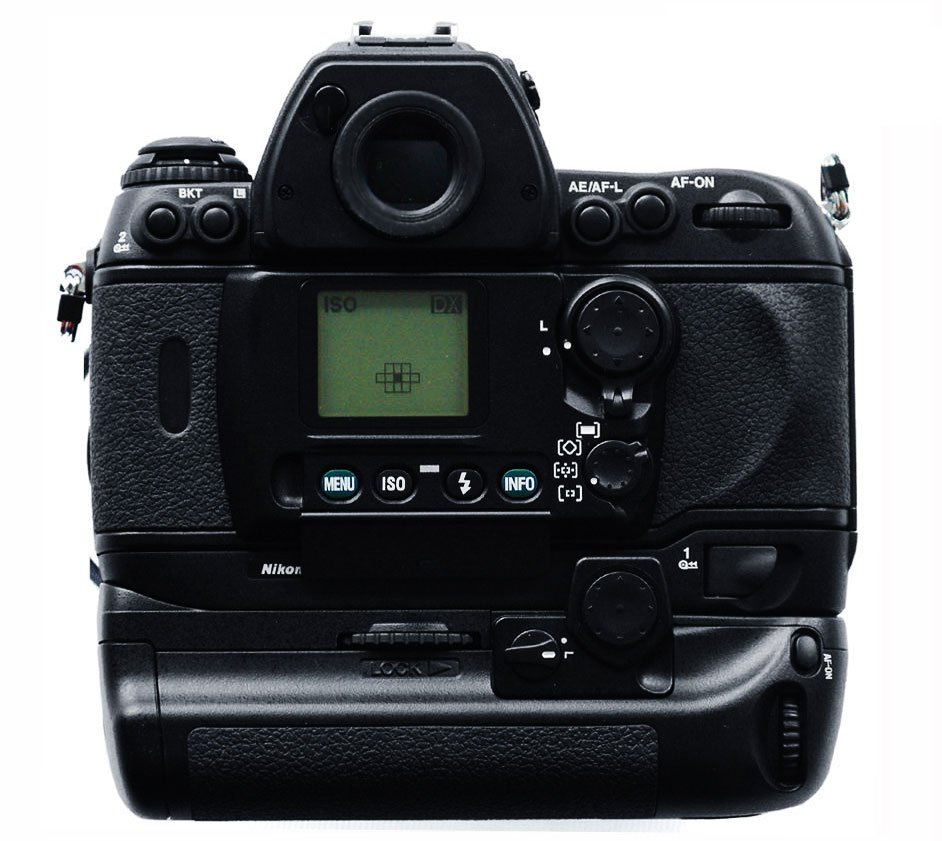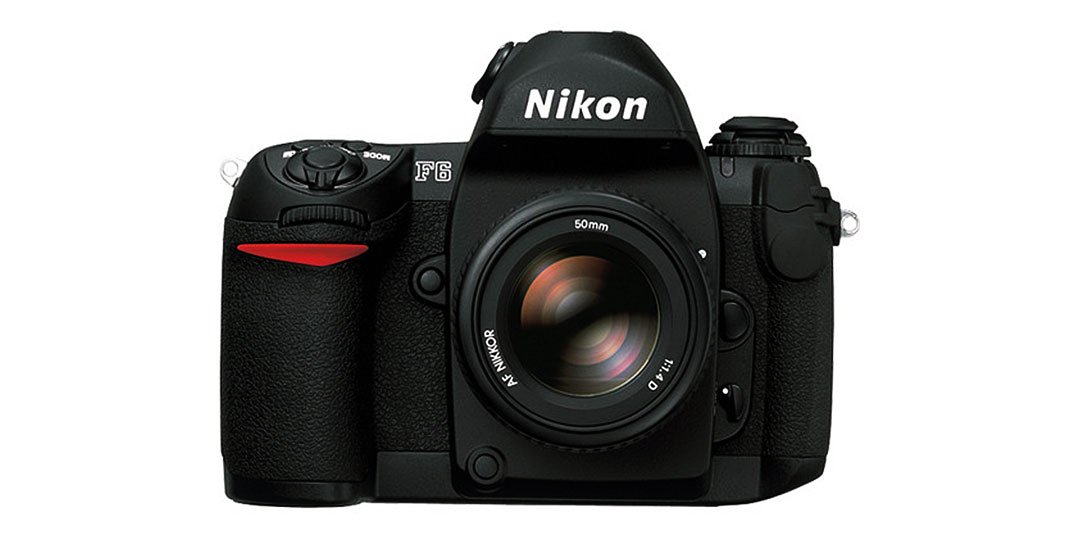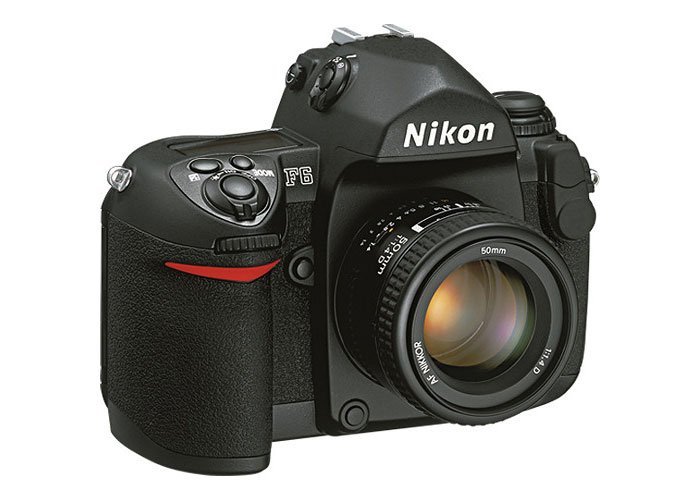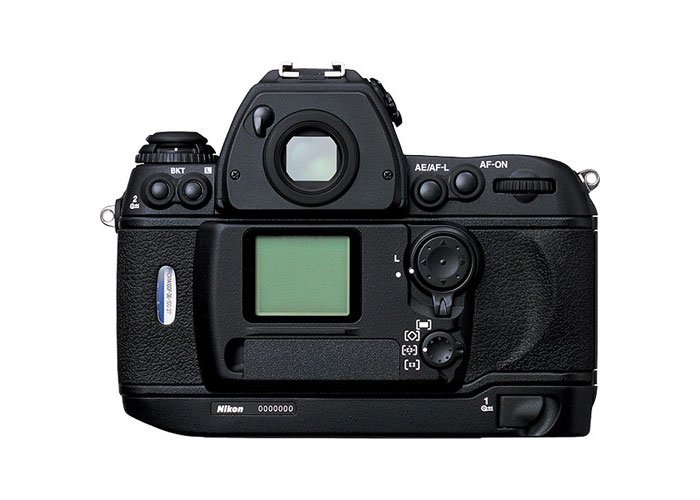The Nikon F6
is a camera I often discount as just Nikon saying, “Hey, we are still the King when it comes to film cameras”! But it’s not. It is truly a marvel. In fact, it’s the only 35mm camera I know of on the B&H website, including Leica’s, that has more than 30 or 40 customer reviews and is still 100% 5 star rated. You’d expect at least one 4 star review! Nope. (Nikon’s latest digital wonder has nothing on an F6,….uhh, except a sensor)
Nikon F6 Review Lite
This is not meant to be an in-depth review. Probably the best full review I’ve seen is over at ByThom.com. It’s extensive and accurate.
Still in Stock
The Nikon F6 is Nikon’s flagship film camera. You can still buy it new. (although Nikon lists it as backordered) The advance design, including an 11-area super accurate AF perfectly melded with Nikon’s awesome Creative Lighting System (iTTL flash) and 3D Color Matrix Metering. Plus a built-in shooting data memory, (my favorite), plus the ability to program custom functions and all the other stuff data backs do.
So, you can customize your shooting preferences with 41 Custom Settings. It also has a greatly improved algorithm 3D Color Matrix metering, a flexible Center Weighted metering and Spot metering that you can assign to any one of 11 focus points. The new AF uses the Multi-CAM 2000 AF Sensor Module and has 9 AF sensors. It has the normal Single Area AF, plus some pretty advanced Dynamic modes, including Focus Tracking with Lock-On, Closest Subject Priority and Group.
Just Like Nikon’s Latest High End Digitals
When using Auto FP High-Speed sync, you can go all the way up to 1/8000 sec! Regular sync is 1/250 sec. You’re also capable of i-TTL Balanced Fill-Flash and Wireless Advance Lighting,…just like Nikon’s latest high-end Digital cameras.
The shutter is some KEVLAR and special aluminum alloy. Super lightweight and super accurate. (should you require that type of accuracy) The data back memory can be downloaded to your computer with the Data Reader MV-1. I didn’t measure the shutter decibels, as I only had the loaner for one day. But I did compare it to an old Leica M, and it’s quieter. How they did that with an SLR is beyond me. It’s a ‘floating design’. I don’t know what that means,…but it’s extremely quiet. The video is interesting because it’s talking about an earlier stage of digital, and even the Mac used is basically now sorta defunct. (to tech heads) In fact, the “Fuck Your Pixel Count” mug is meant for digital photographers who are constantly arguing how many pixels are enough. It was never meant for film photographers,….who don’t care for the most part.
Tech Specs
- Type of Camera: Integral motor autofocus 35mm SLR (Single Lens Reflex) camera with electronically controlled focal-plane shutter.
- Exposure Modes: Programmed Auto, Flexible Program, Shutter priority, Aperture Priority and Manual
- Picture Format: 24mm x 36mm (standard 35mm film format)
- Lens Mount: Nikon F Mount (With AF coupling, AF contacts)
- Usable Lenses: All AF-D, AF-G, AF-I, AF-S and AF VR Nikkor lenses provide full AF and metering operation. AI-P lenses provide manual focus w/electronic rangefinder and full metering operation. AI lenses provide manual focus w/electronic rangefinder, aperture priority and manual exposure mode, C/W and Spot Metering operation.
- Viewfinder: Fixed eyelevel pentaprism, built-in diopter adjustment (-2 to +1m-1)
- Eyepoint: 18mm (at -10m-1)
- Focusing Screen: B Type BriteView clear screen Matte II, interchangeable with six other optional focusing screens
- Autofocus: TTL phase detection, Nikon Multi-CAM 2000 autofocus module
- AF Detection Range: Approx. EV -1 to EV +19 (at ISO 100)
- AF Area Mode: Single Area AF, Dynamic AF, Group Dynamic AF or Dynamic AF with Closest Subject Priority
- Metering System: Three built-in exposure meters; 1005 Pixel RGB 3D Color Matrix II, Flexible Center Weighted and Eleven Spot meters
- Metering Range: (at ISO 100 with f/1.4 lens) EV 0 to EV 20 in 3D Color Matrix II and Center-Weighted, EV 2 to EV 20 in Spot
- Exposure Compensation: With exposure compensation button; + 5 EV range, in 1/3, 1/2 or 1 EV steps
- Auto Exposure Bracketing: Built-in; Number of shots; 2-7 compensation steps 1/3, 1/2, 2/3 or 1 EV steps
- Auto Exposure Lock: By pressing AE-L/AF-L Button
- Film Speed Setting: ISO 25 to 5000 for DX-coded film; ISO 6 to 6400 can be manually set
- Shutter: Electromagnetically controlled vertical-travel focal-plane shutter with built-in shutter monitor
- Flash Synchronization: In Programmed Auto or Aperture-Priority Auto, shutter operates from 1/250 to 1/60 sec. in normal sync. 1/250 to 30 sec. In slow sync; in Shutter-Priority Auto or Manual exposure mode, shutter operates at speed set, or at 1/250 if speed is set between 1/250 and 1/8000 sec. Auto FP High Speed Sync with Custom Setting in all modes to 1/8000sec.
- Flash Control: TTL flash control by combined Five Segment TTL Multi-Sensor with single component IC and 1,005 Pixel RGB sensor; i-TTL Balanced Fill-Flash with SB-600/800; film speed range in TTL auto flash: ISO 25-1000
- Ready Light: Speedlight attached, lights up in red when Nikon dedicated Speedlight is ready to fire, or blinks to warn of insufficient light for correct exposure
- Accessory Shoe: ISO518 hot shoe contact, digital data communication (sync contact, ready light contact, TTL Auto flash contact, monitor contact, GND) safety lock provided
- Self Timer: Electronically controlled; 10 second duration; blinking LED indicates self-timer operation; cancelable
- Film Loading: Film automatically advances to first frame when camera back is closed
- Film Advance: Automatic advance with built-in motor, three modes available (S: for one frame advance, CL: Continuous low speed shooting, CH: Continuous high-speed shooting, CS: Continuous silent low-speed shooting)
- Film Rewind: Choice of automatic or manual; automatically rewinds at the end of the roll or when two film rewind buttons are pressed, rewind speed with 36 exp, roll of film Approx. 7 seconds (12 seconds in CS Mode)
- Multiple Exposure: Activated via shooting menu
- Power Source: Battery Holder MS-41 provided (two 3V Lithium batteries) Optional Multi Power Battery Pack MB-40 and AA type battery holder MS-40 available (for eight alkaline manganese, lithium or NiMH batteries or one rechargeable Li-ion Battery EN-EL4); built-in battery back up
- Weight (without batteries): Approx. 34.4 oz
- Dimensions (WxHxD): 6.2 x 4.7 x 3.1 inches
A Solid Beauty
The Nikon F6 body is a combination of aluminum alloy and magnesium alloy, making it very light but solid. It is water resistant and dust resistant. It’s quite a film camera, and the back LCD is for the menus and provides shooting info.
The Nikon MB-40
The Nikon MB-40 Multi-Power Battery Pack takes eight AA batteries, alkaline, lithium, or Ni-MH. It also can take a rechargeable Li-ion Battery EN-EL4. Beside increasing speed to 8 fps, it also acts as a vertical grip with shutter release. I know that seems slow to digital guys, but remember you are still moving film along here.

This is a very beautiful camera. And you can still use you AI lenses! Nikon is really telling people with this camera that they are still a camera company. The biggest complaints I found on the net were that the Nikon F6 does too much. And to confess,…I still use the F4s and F5. Users have features they just may never access. Well, that’s a pretty good complaint. Find Nikon F6
Addendum;
Nikon has issued a partial recall of the Nikon F6. The recall is due to the detected presence of dibutyl phthalate (DBP) in very limited production runs of the Nikon F6. and only because of new restrictions imposed by legislation in the European Union only.
The Nikon F6 has been in production for over 16 years, in an era when film cameras are commonly considered dead. However, there are photographers out there still buying and using it. It shows Nikon’s commitment to film, (although small), to photography and photographers. While all the rest sadly jumped ship ages ago. (save Leica, some large format guys, etc.) This includes the failed Olympus and their stupid “Four Thirds” garbage. (my very opinionated take) So, to all the companies, who completely abandoned film, I can say it best with pictures;

Only certain batches of the F6 contain DBP, (from certain suppliers), which is an endocrine disruptor that may cause birth defects and cancerous tumors. The concentration of the compound (which is used as a plasticizer) are highly regulated around the world, and in this case, they exceeded the safe amounts legislated by the European Union. (those amounts differ in other countries)
Nikon Notice
“While Nikon has taken great measures to assure the high quality expected of Nikon products, it has come to our attention that some components containing levels of dibutyl phthalate (DBP) that potentially exceed the standard value specified in the European Union regulation, the RoHS Directive,* have been used in some F6 film SLR cameras manufactured and/or sold after July 22, 2019,” states the global service advisory notice.
“For those who have already purchased an affected F6 film SLR camera, and would like to have their camera serviced to correct this issue, Nikon’s service center will service cameras as needed free of charge to the customer, including the cost of shipping affecting F6 film SLR cameras to Nikon, as well as their return postage to customers,… even if the warranty has expired.”
Yay, Nikon. Stepping up to the plate once more.
The recall only affects a the following serial numbers of 152 cameras: (if you’re anywhere other than in the European Union, this regulation does not apply, but you still qualify for free service.)
0035842, 0035862, 0035867, 0035868, 0035869, 0035870, 0035871, 0035872, 0035873, 0035909, 0035910, 0035911, 0035912, 0035913, 0035914, 0035915, 0035916, 0035917, 0035918, 0035919, 0035920, 0035921, 0035922, 0035923, 0035924, 0035925, 0035926, 0035927, 0035928, 0035929, 0035930, 0035932, 0035934, 0035941, 0035942, 0035943, 0035944, 0035945, 0035946, 0035947, 0035948, 0035949, 0035950, 0035951, 0035952, 0035953, 0035954, 0035955, 0035956, 0035957, 0035958, 0035959, 0035968, 0035969, 0035970, 0035971, 0035972, 0035973, 0035974, 0035975, 0035976, 0035977, 0035978, 0035979, 0035980, 0035981, 0035983, 0035984, 0035985, 0035986, 0035987, 0035989, 0035990, 0035991, 0035992, 0036010, 0036011, 0036012, 0036013, 0036014, 0036015, 0036016, 0036017, 0036018, 0036019, 0036020, 0036021, 0036022, 0036023, 0036024, 0036025, 0036026, 0036027, 0036028, 0036029, 0036030, 0036031, 0036032, 0036033, 0036034, 0036035, 0036036, 0036037, 0036038, 0036039, 0036041, 0036042, 0036043, 0036045, 0036046, 0036047, 0036048, 0036049, 0036050, 0036051, 0036052, 0036053, 0036056, 0036057, 0036058, 0036062, 0036112, 0036114, 0036116, 0036130, 0036133, 0036134, 0036135, 0036136, 0036137, 0036138, 0036139, 0036140, 0036141, 0036142, 0036147, 0036149, 0036153, 0036154, 0036155, 0036156, 0036157, 0036158, 0036159, 0036160, 0036161, 0036162, 0036165, 0036177, 0036188, 0036189, 0036191





Simply the best AF Nikon film camera! I’ve had one that I purchased second-hand for a few years now and it’s incredible, so much so that I have just bought a brand new one ( June 2018 ) from Grays of Westminster in London, UK. Contrary to some stories out there it IS still being made, apparently ( according to Grays ) mine, which is one of two they recently had into stock was built at the Sendai plant in April 2018, it’s serial number is in the 35k region. I believe they are now built in very small batches as and when an order or two comes in. I’m tempted to get another when Grays have their next delivery.
Can anybody recommend a good book that dices all of the options available and how to fully use them on this camera.
Hi Gary,
If you’re just looking for a manual to download,… https://www.nikonsupport.eu/europe/Manuals/dGtUxUnN9l/F6-En_02.pdf
If you want an E-Book with all the ins and outs, Thom Hogan has the most complete one; https://www.filmbodies.com/accessories/complete-guides/complete-guide-to-the-nikon-6.html
Of course, you get a “free” manual when you buy the camera. 😁
Federico
is there a video that walks you through how to use the options in the back?
Hi Jen,
While there are many YouTube videos addressing use and praising the F6, I don’t know of any that only addresses the custom functions input directly on the back, or downloading all the shooting info with the optional MV-1. Maybe a fellow Nikonian can chime in here if they know of a link. Probably because, compared to most digital cameras, it’s quite simple and straightfoward. However, it is covered extensively in the Nikon F6 Manual. Pages 87-148 are the”Menu Guide” dedicated to setting up and downloading pretty much everything.
Federico
I often think I am going to buy one but my F5 is still going strong…. I wonder though if any one of the many photographers have been dealing with defects pertaining to the hardware or circuit boards? I understand to that the internal clock battery will cease to operate one day. Yes the F5 is plentifyl on the used market only because the F6 came out. However, please let me know your experience with any issues with the f6 and would you recommend it to me… for now my comparison of the F6 is a supped up f100 camera with limitations.. change my mind…
I’m having trouble with my F6 and wondering if someone here can help. I’m working in fully manual mode and using back-button focus. The shutter button is only used for metering, and of course, triggering the shutter. However, I am running into the problem of the camera not allowing me to fully press the shutter button unless I am holding down the exposure lock button on the back of the camera. If I’m in full manual mode, why would the camera be doing this and not allowing me to take the photo that I want without holding down that button?
Hi Marilyn,
First, make sure the battery is fully charged. Check the lens to make sure it is properly attached. Don’t set the Drive Mode to Self-Timer.
Make sure it isn’t in a timed delay mode. (e.g. it’s not set for the 10 second timer)
Make sure the camera is not in “Focus Priority” which means it will refuse to take a shot if it cannot confirm that the camera was able to lock focus on at least one focus point. In poor lighting, the camera may simply refuse to take a shot. This is normal — not a defect. You can override this by switching off auto-focus (go to manual focus on the lens) or by switching to “AI Servo” mode which changes the behavior to “Release Priority” whcih means the camera will take the shot when the shutter button is fully pressed… even if it believes it was not able to focus.
Are you in a situation with very low light? The camera may give up attempting to focus if the lighting is not adequate to lock focus. You can test by checking the camera outdoors during the daytime when there’s plenty of available light. Pressing Exposure lock will override the camera refusing to release shutter. It’s suppose to do that in every mode. There’s also a custom mode in which you have to press the shutter button twice to get the camera to take a shot.
There are a few other things which are a bit more obscure, but my walnut sized brain is limited. Focus Priority is the most likely culprit. Put it in Release Priority. I’m sure you have a manual, but just in case;
https://www.bhphotovideo.com/lit_files/42037.pdf
Hope this helps or someone comes up with a better answer. 😊
AF